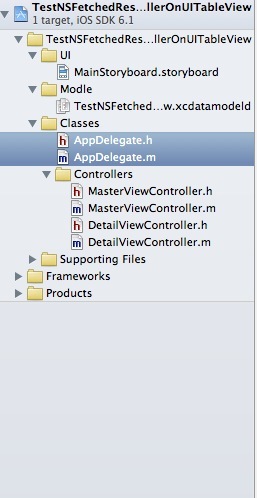NSFetchedResultsController
什么是NSFetchedResultsController
NSFetchedResultsController是一个让人爱恨交加的一个类。如果使用得当,NSFetchedResultsController能帮组减少很多代码。如果使用不当,整个App就随时崩溃。
NSFetchedResultsController我觉得最初的设计应该是为了配合UITableView来使用的。因为UITableView在iOS的应用App中出场次数实在是太高了.而且UITableView是重要的数据展示View,所以需要频繁的向Model去请求数据,但是根据MVC来说,V不应该直接跟M联系的.这样就在Core Data下面出现了一个C—NSFetchedResultsController来把V和M协调起来. NSFetchedResultsController就是这个C.
NSFetchedResultsController是有两个重要的功能。
第一:NSFetchedResultsController是作用在Core Data上的,通过NSFetchRequest来查询Core Data里面的数据.可以返回按照组分好的数据.这样便于UITableView来显示.
第二:但Modle改变的时候NSFetchedResultsController能及时的发出通知.准确的说,应该是当NSManagedObjectContext发生改变的时候,NSFetchedResultsController能知道这些变化,然后发出通知出来.以便UITableview能及时的更新.
实现一个NSFetchedResultsController作为Data source的UITableView
创建一个最小带Core Data的工程
选择Master-Detail Application
整理一下显示层级和结构使其看起来顺眼一些
确立目标
打开看以后 发现建立的工程是已经使用了NSFetchedResultsController
我们的目标是改写这个项目支持UITableView分组显示
首先修改Data Model
增加一个字段用来分组. 我们增加一个同样的Date用来记录此时的分钟数量.
初始化一个NSFetchedResultsController
这里假设你看过我的Core Data笔记1,2.默认你已经做好了Core Data stack的全部工作.然后再开始NSFetchedResultsController的初始化.
- (NSFetchedResultsController *)fetchedResultsController
{ if (_fetchedResultsController != nil) {
return _fetchedResultsController;
}
NSFetchRequest *fetchRequest = [[NSFetchRequest alloc] init];
// Edit the entity name as appropriate.
NSEntityDescription *entity = [NSEntityDescription entityForName:@"Event" inManagedObjectContext:self.managedObjectContext];
[fetchRequest setEntity:entity];
// Set the batch size to a suitable number.
[fetchRequest setFetchBatchSize:20];
// Edit the sort key as appropriate.
NSSortDescriptor *sortDescriptor = [[NSSortDescriptor alloc] initWithKey:@"timeStamp" ascending:NO];
NSArray *sortDescriptors = @[sortDescriptor];
[fetchRequest setSortDescriptors:sortDescriptors];
// Edit the section name key path and cache name if appropriate.
// nil for section name key path means "no sections".
NSFetchedResultsController *aFetchedResultsController = [[NSFetchedResultsController alloc] initWithFetchRequest:fetchRequest managedObjectContext:self.managedObjectContext sectionNameKeyPath:@"sectionMinute" cacheName:@"Master"];
aFetchedResultsController.delegate = self;
self.fetchedResultsController = aFetchedResultsController;
NSError *error = nil;
if (![self.fetchedResultsController performFetch:&error]) {
// Replace this implementation with code to handle the error appropriately.
// abort() causes the application to generate a crash log and terminate. You should not use this function in a shipping application, although it may be useful during development.
NSLog(@"Unresolved error %@, %@", error, [error userInfo]);
abort();
}
return _fetchedResultsController;
}这里是工程里面的NSFetchedResultsController的set方法.可以看出,第一我们创建一个NSFetchRequest查询.然后在用这个NSFetchRequest去创建一个NSFetchedResultsController.
NSFetchedResultsController *aFetchedResultsController = [[NSFetchedResultsController alloc] initWithFetchRequest:fetchRequest managedObjectContext:self.managedObjectContext sectionNameKeyPath:@"sectionMinute" cacheName:@"Master"];第一个参数就是NSFetchRequest.
第二个参数是要指定在哪个context里面进行查询
第三个参数是根据什么key来分组.sectionNameKeyPath本来是nil是不分组,我改为我们需要分组的key值“sectionMinute”.
第四个参数 官方解释是这里点到The Cache的地方. 我的理解是cache只保留很少的一部分数据在磁盘上面,如果使用了Cache,在重建UITableView的时候, 就优先查询cache里面的数据.然后要在-performFetch:执行的时候才会去刷新新的数据.这样有助于UITableView的流畅性.
然后我加入Sections的方法
- (NSString *)tableView:(UITableView *)tableView titleForHeaderInSection:(NSInteger)section
{
NSArray *sections = [[self fetchedResultsController] sections]; id <NSFetchedResultsSectionInfo> sectionInfo = nil;
sectionInfo = [sections objectAtIndex:section];
return [sectionInfo name];
}接着我添加
https://github.com/erica/NSDate-Extensions.git这个NSDate库进来.自己按照他的写法,写一个能获得当前时间秒数为0的方法.用来分组.
- (NSDate *) dateAtStartOfMinutes
{ NSDateComponents *components = [CURRENT_CALENDAR components:DATE_COMPONENTS fromDate:self];
[components setSecond:0];
return [CURRENT_CALENDAR dateFromComponents:components];
}然后改写insert方法
- (void)insertNewObject:(id)sender
{
NSManagedObjectContext *context = [self.fetchedResultsController managedObjectContext];
NSEntityDescription *entity = [[self.fetchedResultsController fetchRequest] entity];
NSManagedObject *newManagedObject = [NSEntityDescription insertNewObjectForEntityForName:[entity name] inManagedObjectContext:context];
// If appropriate, configure the new managed object.
// Normally you should use accessor methods, but using KVC here avoids the need to add a custom class to the template.
[newManagedObject setValue:[NSDate date] forKey:@"timeStamp"];
[newManagedObject setValue:[[NSDate date] dateAtStartOfMinutes] forKey:@"sectionMinute"];
// Save the context.
NSError *error = nil; if (![context save:&error]) {
// Replace this implementation with code to handle the error appropriately.
// abort() causes the application to generate a crash log and terminate. You should not use this function in a shipping application, although it may be useful during development.
NSLog(@"Unresolved error %@, %@", error, [error userInfo]);
abort();
}
}其实就是加入了
[newManagedObject setValue:[[NSDate date] dateAtStartOfMinutes] forKey:@"sectionMinute"];这句.
这样,简单的使用NSFetchedResultsController来显示分组的UITableView就搞定了.
当然因为建立的工程模板原因.很大一部分都是xCode搞定的.
被遗忘的地方
Sections数量,决定了有多少组
- (NSInteger)numberOfSectionsInTableView:(UITableView *)tableView
{ return [[self.fetchedResultsController sections] count];
}如果在初始化NSFetchedResultsController的时候sectionNameKeyPath为nil.这里应该会返回1.(就算没有数据也会返回1)
Row数量,决定每一组分别有多少行数据.
- (NSInteger)tableView:(UITableView *)tableView numberOfRowsInSection:(NSInteger)section
{ id <NSFetchedResultsSectionInfo> sectionInfo = [self.fetchedResultsController sections][section];
return [sectionInfo numberOfObjects];
}我前面说过NSFetchedResultsController就是为了配合UITableView而设计的.所以自然有根据indexPath来取对应的NSManagedObject的方法.
- (UITableViewCell *)tableView:(UITableView *)tableView cellForRowAtIndexPath:(NSIndexPath *)indexPath
{
UITableViewCell *cell = [tableView dequeueReusableCellWithIdentifier:@"Cell" forIndexPath:indexPath];
[self configureCell:cell atIndexPath:indexPath];
return cell;
}
- (void)configureCell:(UITableViewCell *)cell atIndexPath:(NSIndexPath *)indexPath
{
NSManagedObject *object = [self.fetchedResultsController objectAtIndexPath:indexPath];
cell.textLabel.text = [[object valueForKey:@"timeStamp"] description];
}show
总结
写Blog实在是太累了. NSFetchedResultsController努力一天也才一点点.回去继续写. 下次要写NSFetchedResultsController通知方法.


























 1116
1116

 被折叠的 条评论
为什么被折叠?
被折叠的 条评论
为什么被折叠?








